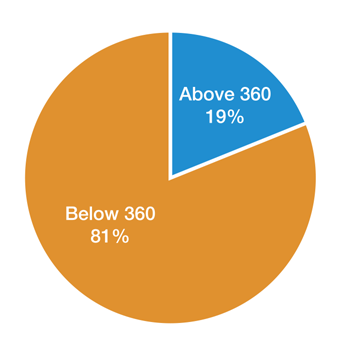Northeast
District K-8 Schools in the Northeast Region with 2017-18 enrollment above 360 students
SOURCE: 2017-18 ODE headcount enrollment data for grades K-8
- Only 19% of District K-8 schools are above the minimum enrollment target of 360 students, by far the lowest of any region. None of the schools in the region meet the desired enrollment of 450 students.
- Nearly half of District K-8 schools in the region have experienced a negative enrollment trend over the last five years and only one school has a positive enrollment trend.
- Regional enrollment has declined by 8.4% since 2013 and is forecast to decline another 8.6% by 2022-23, both the largest declines of any region. These trends suggest it will continue to be hard for all schools in the region to achieve even minimum enrollment targets.
East
District K-8 Schools in the East Region with 2017-18 Enrollment Above 360 Students
SOURCE: 2017-18 ODE headcount enrollment data for grades K-8
- 33% of District K-8 schools are above the minimum sustainability target of 360 students, the second lowest rate of any region. Two of the nine schools in the region meet the desired enrollment size of 450 students.
- Charter closures in the area in recent years have allowed most District schools in the region to maintain or increase enrollment, with only one District K-8 school experiencing a negative enrollment trend over the last five years.
Southeast
District K-8 Schools in the Southeast Region with 2017-18 Enrollment Above 360 Students
SOURCE: 2017-18 ODE headcount enrollment data for grades K-8
- 62% of District K-8 schools are above the minimum sustainability target of 360 students, but only three of 13 regional schools meet the desired size of 450 students.
- 54% of District K-8 schools in the region have experienced a negative enrollment trend over the last five years.
Near West
District K-8 Schools in the Near West Region with 2017-18 Enrollment Above 360 Students
SOURCE: 2017-18 ODE headcount enrollment data for grades K-8
- 64% of District K-8 schools are above the minimum sustainability target of 360 students, with 36% achieving the desired enrollment of 450.
- All but one school in this region have experienced steady or increasing enrollment over the last five years, driven largely by out-of-region students choosing Near West schools.
- Despite school-level enrollment trends, regional enrollment is forecast to decline 7.9% by 2022-23, suggesting that additional schools may have viability risks in the future.
West
District K-8 Schools in the West Region with 2017-18 Enrollment Above 360 Students
SOURCE: 2017-18 ODE headcount enrollment data for grades K-8
- 71% of District K-8 schools are above the minimum sustainability target of 360 students, which is the highest rate of any region. Three of the seven regional schools meeting the desired enrollment threshold of 450 students.
- Most schools in the region (five of the seven) have experienced a steady or positive enrollment trend over the last five years.
Southwest
District K-8 Schools in the Southwest Region with 2017-18 Enrollment Above 360 Students
SOURCE: 2017-18 ODE headcount enrollment data for grades K-8
- 63% of District K-8 schools are enrolled at levels above both the minimum sustainability target of 360 students and the desired size of 450 students.
- All but one school in this region have experienced steady or increasing enrollment over the last five years.









